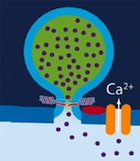
CNCR-researchers publish in Science on the configuration of fusion complexes in secretion
The study led by long-term collaborator Jakob Sorensen and also involving Nobel laureate Erwin Neher reveals the exact stoichiometry of the multiprotein complex that drives fusion of secretory vesicles.
The molecular machine that drives membrane fusion during secretion requires formation of a complex of so-called SNARE proteins that consists of a coiled bundle of four parallel –helices between the plasma membrane and the vesicle.
CNCR-researchers Matthijs Verhage and Heidi de Wit are part of a collaboration, which developed an elegant approach to find out how many SNARE complexes are required to promote secretion of individual secretory vesicles in living cells by titrating the ratio of wild-type and mutant SNARE proteins expressed. Fast, synchronous fusion typically observed in synapses and neurosecretory cells requires at least three functional SNARE 
complex number may explain heterogeneity in vesicular release probability, an important unexplained feature of synapses with a large influence on synaptic strength and –endurance.
The study is coordinated by long-term CNCR collaborator Jakob Sorensen, with whom Heidi & Matthijs previously elucidated the minimal requirements for vesicle docking, published in Cell last year, and also performed several other studies together, for instance on rab proteins and munc18.
Science_Mohrmann.pdf (724.19 KB)